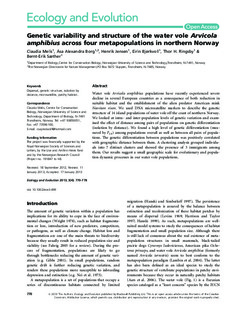| dc.contributor.author | Melis, Claudia | |
| dc.contributor.author | Borg, Åsa Alexandra | |
| dc.contributor.author | Jensen, Henrik | |
| dc.contributor.author | Bjørkvoll, Eirin Marie | |
| dc.contributor.author | Ringsby, Thor Harald | |
| dc.contributor.author | Sæther, Bernt-Erik | |
| dc.date.accessioned | 2017-12-08T09:46:16Z | |
| dc.date.available | 2017-12-08T09:46:16Z | |
| dc.date.created | 2013-01-17T18:25:28Z | |
| dc.date.issued | 2013 | |
| dc.identifier.citation | Ecology and Evolution. 2013, 3 (4), 770-778. | nb_NO |
| dc.identifier.issn | 2045-7758 | |
| dc.identifier.uri | http://hdl.handle.net/11250/2469703 | |
| dc.description.abstract | Water vole Arvicola amphibius populations have recently experienced severe decline in several European countries as a consequence of both reduction in suitable habitat and the establishment of the alien predator American mink Neovison vison. We used DNA microsatellite markers to describe the genetic structure of 14 island populations of water vole off the coast of northern Norway. We looked at intra- and inter-population levels of genetic variation and examined the effect of distance among pairs of populations on genetic differentiation (isolation by distance). We found a high level of genetic differentiation (measured by FST) among populations overall as well as between all pairs of populations. The genetic differentiation between populations was positively correlated with geographic distance between them. A clustering analysis grouped individuals into 7 distinct clusters and showed the presence of 3 immigrants among them. Our results suggest a small geographic scale for evolutionary and population dynamic processes in our water vole populations. | nb_NO |
| dc.language.iso | eng | nb_NO |
| dc.publisher | Wiley | nb_NO |
| dc.rights | Navngivelse 4.0 Internasjonal | * |
| dc.rights.uri | http://creativecommons.org/licenses/by/4.0/deed.no | * |
| dc.title | Genetic variability and structure of the water vole Arvicola amphibius across four metapopulations in northern Norway | nb_NO |
| dc.type | Journal article | nb_NO |
| dc.type | Peer reviewed | nb_NO |
| dc.description.version | publishedVersion | nb_NO |
| dc.source.pagenumber | 770-778 | nb_NO |
| dc.source.volume | 3 | nb_NO |
| dc.source.journal | Ecology and Evolution | nb_NO |
| dc.source.issue | 4 | nb_NO |
| dc.identifier.doi | 10.1002/ece3.499 | |
| dc.identifier.cristin | 991600 | |
| dc.relation.project | Norges forskningsråd: 191847 | nb_NO |
| dc.relation.project | Norges forskningsråd: 204303 | nb_NO |
| dc.relation.project | Norges forskningsråd: 223257 | nb_NO |
| dc.description.localcode | © 2013 The Authors. Ecology and Evolution published by Blackwell Publishing Ltd. This is an open access article under the terms of the Creative Commons Attribution License, which permits use, distribution and reproduction in any medium, provided the original work is properly cited | nb_NO |
| cristin.unitcode | 194,66,10,0 | |
| cristin.unitname | Institutt for biologi | |
| cristin.ispublished | true | |
| cristin.fulltext | original | |
| cristin.qualitycode | 1 | |

